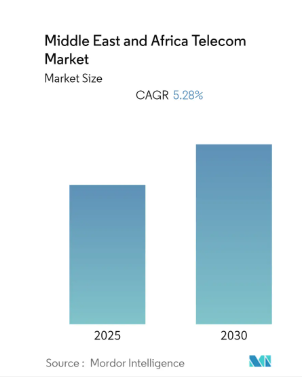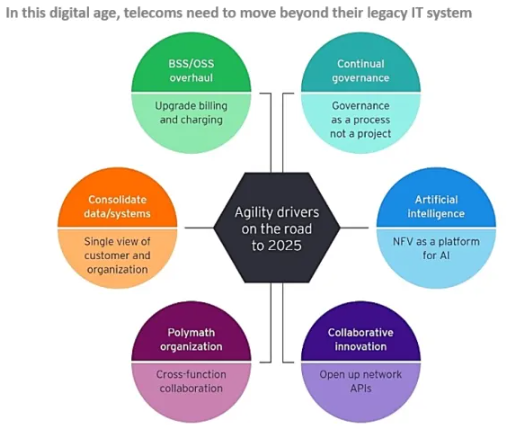Source: Mordor Intelligence
1. The Weight of Legacy Systems
- Lack of Agility: These systems cannot adapt to the fast-paced changes in the telecom industry, such as the introduction of 5G or customer-centric service models.
- Data Silos: Legacy systems often operate in isolation, preventing a unified view of customers and leading to missed personalization opportunities. For example, operators with fragmented data report up to 30% slower response times to customer inquiries.
- High Maintenance Costs: Maintaining outdated systems drains resources that could otherwise be invested in innovation and modernization.
- Telecom operators lose up to $6 million annually due to customer churn linked to poor service quality.
- Operational inefficiencies add 5-10% to overall costs.
Source: AIMultiple
2. Operational Inefficiencies
Operational inefficiencies are a critical pain point for Tier-2 and Tier-3 telecom operators. From manual workflows to redundant processes, these inefficiencies hinder growth and customer satisfaction.
Key Challenges:
- Slow Time-to-Market: Launching new services or promotions often takes weeks or months due to inefficient processes.
- Fragmented Operations: Without integrated systems, managing operations across departments becomes a logistical nightmare.
- Resource Constraints: Smaller operators often lack the financial and human resources to address these inefficiencies effectively.
Missed Opportunities:
- Delays in launching services result in missed revenue opportunities.
- Inefficient processes increase operating costs, reducing profitability.
Solution:
Streamlining operations with automation tools and modern telecom CRM solutions can:
- Automate service activation to minimize manual errors.
- Accelerate time-to-market. (Quick and efficient rollout of new offerings)
- Improve overall operational efficiency.
3. Evolving Customer Expectations
Telecom customers in emerging markets are becoming increasingly sophisticated. They demand seamless experiences, real-time service, and personalized engagement. Failing to meet these expectations can lead to churn and reputational damage.
What Customers Expect:
- Real-Time Solutions: Instant activation of services, real-time data monitoring, and quick issue resolution are now baseline expectations.
- Personalization: Customers want tailored offers based on their usage patterns and preferences.
- Proactive Engagement: Operators are expected to anticipate customer needs and resolve potential issues before they arise. AI-driven customer insights can predict churn with up to 90% accuracy, allowing proactive engagement.
The Cost of Falling Short:
- Studies show that 56% of customers are likely to switch providers after a single bad experience.
- Declining ARPU (Average Revenue Per User) is often linked to poor customer satisfaction.
Solution:
Adopting modern technologies like AI, machine learning, and advanced analytics can help operators:
- Provide real-time, personalized experiences.
- Predict customer behavior to reduce churn.
- Deliver proactive solutions that enhance loyalty and ARPU.
- Send personalized offers based on real-time usage data.
4. Navigating Regulatory Complexity
Emerging markets often have complex and evolving regulatory environments that add another layer of operational difficulty for telecom operators. Compliance with local regulations can be time-consuming and costly.
Challenges:
- Frequent Changes: Regulatory frameworks in these regions are often subject to rapid changes.
- Hidden Costs of Compliance: Meeting regulatory requirements such as data localization laws or spectrum allocation complexities.
- Risk of Penalties: Non-compliance can lead to hefty fines and reputational damage.
Solution:
Modern telecom CRM and operational systems can:
- Ensure compliance through automated workflows and reporting.
- Provide real-time updates on regulatory changes.
- Reduce the cost and complexity of meeting compliance requirements.
- Automating compliance reporting reduced penalty risks by 25% for a Tier-2 operator.
5. The Path to Modernization
Modernizing operations is the most effective way for Tier-2 and Tier-3 telecom operators to overcome these challenges. This involves investing in advanced systems and adopting customer-centric strategies.
Steps to Modernization:
- Adopt Modern Telecom CRM Solutions: CRM Platforms like AviateCX are designed specifically for telecom operators, offering features such as unified customer views, advanced analytics, and automation. AviateCX integrates advanced analytics with real-time dashboards tailored for telecom operators.
- Embrace Automation: Automating repetitive tasks can free up resources and reduce errors.
- Leverage Data Analytics: Advanced analytics can provide actionable insights to improve decision-making and customer engagement. Use analytics to identify high-value customers and tailor retention strategies.
- Invest in Training: Equip teams with the skills needed to manage and operate modern systems effectively. Focus on AI integration, customer data management, and compliance automation.
Benefits of Modernization:
- Improved Efficiency: Streamlined processes reduce operational costs and improve productivity.
- Enhanced Customer Satisfaction: Personalized and proactive engagement boosts loyalty and ARPU.
- Faster Growth: Agile systems enable operators to scale quickly and respond to market changes effectively.
6. Real-World Results
Operators who have embraced modernization have reported significant improvements:
- 20-30% increase in customer satisfaction scores.
- 15-20% reduction in churn rates.
- Significant boosts in ARPU through targeted upselling and cross-selling campaigns.
For instance, Tier-3 operators in Middle East and Africa can see the following results if they implement a modern telecom CRM solution like AviateCX:
- A 25% reduction in customer complaints.
- A 30% increase in new subscriber acquisition.
Takeaway
While Tier-2 and Tier-3 telecom operators in emerging markets face significant operational hurdles, these challenges present an opportunity for transformation. By modernizing systems and embracing innovative solutions, operators can overcome inefficiencies, meet evolving customer demands, unlock new revenue streams and stay competitive in a rapidly changing industry.
Modernization is not just about keeping up, it is the key to staying ahead in a competitive telecom landscape. AviateCX is here to help Tier-2 and Tier-3 telecom operators like you to navigate this transformation with a telecom-specific CRM solution tailored to your needs. Start your journey to telecom modernization today!



